Sonal Gupta
Text-to-Sticker: Style Tailoring Latent Diffusion Models for Human Expression
Nov 17, 2023



Abstract:We introduce Style Tailoring, a recipe to finetune Latent Diffusion Models (LDMs) in a distinct domain with high visual quality, prompt alignment and scene diversity. We choose sticker image generation as the target domain, as the images significantly differ from photorealistic samples typically generated by large-scale LDMs. We start with a competent text-to-image model, like Emu, and show that relying on prompt engineering with a photorealistic model to generate stickers leads to poor prompt alignment and scene diversity. To overcome these drawbacks, we first finetune Emu on millions of sticker-like images collected using weak supervision to elicit diversity. Next, we curate human-in-the-loop (HITL) Alignment and Style datasets from model generations, and finetune to improve prompt alignment and style alignment respectively. Sequential finetuning on these datasets poses a tradeoff between better style alignment and prompt alignment gains. To address this tradeoff, we propose a novel fine-tuning method called Style Tailoring, which jointly fits the content and style distribution and achieves best tradeoff. Evaluation results show our method improves visual quality by 14%, prompt alignment by 16.2% and scene diversity by 15.3%, compared to prompt engineering the base Emu model for stickers generation.
Make-An-Animation: Large-Scale Text-conditional 3D Human Motion Generation
May 16, 2023Abstract:Text-guided human motion generation has drawn significant interest because of its impactful applications spanning animation and robotics. Recently, application of diffusion models for motion generation has enabled improvements in the quality of generated motions. However, existing approaches are limited by their reliance on relatively small-scale motion capture data, leading to poor performance on more diverse, in-the-wild prompts. In this paper, we introduce Make-An-Animation, a text-conditioned human motion generation model which learns more diverse poses and prompts from large-scale image-text datasets, enabling significant improvement in performance over prior works. Make-An-Animation is trained in two stages. First, we train on a curated large-scale dataset of (text, static pseudo-pose) pairs extracted from image-text datasets. Second, we fine-tune on motion capture data, adding additional layers to model the temporal dimension. Unlike prior diffusion models for motion generation, Make-An-Animation uses a U-Net architecture similar to recent text-to-video generation models. Human evaluation of motion realism and alignment with input text shows that our model reaches state-of-the-art performance on text-to-motion generation.
Latent-Shift: Latent Diffusion with Temporal Shift for Efficient Text-to-Video Generation
Apr 18, 2023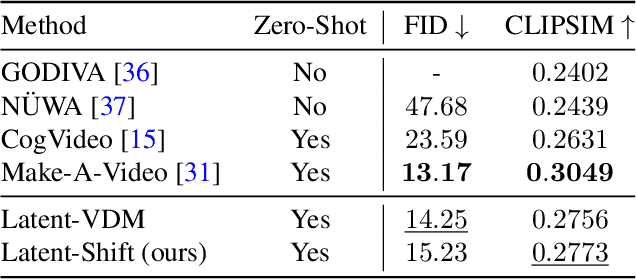
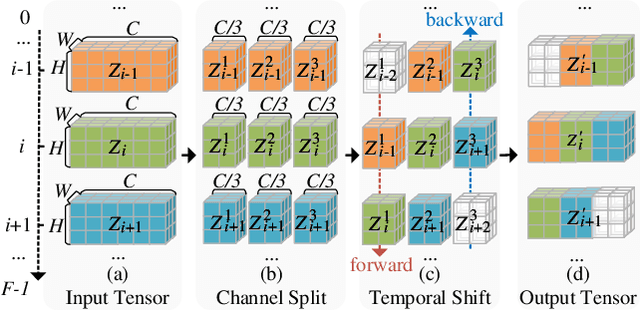
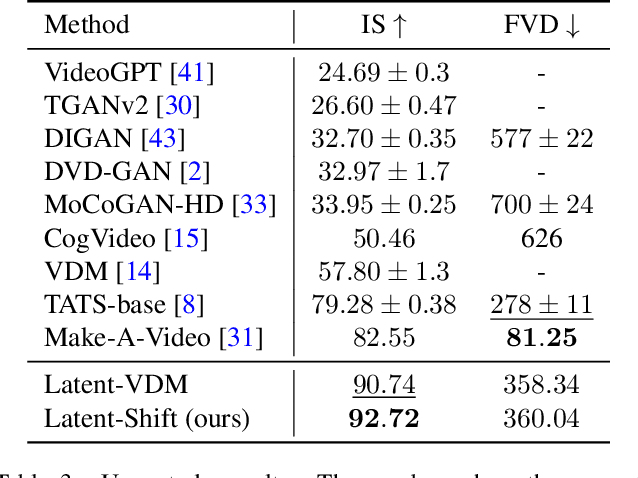
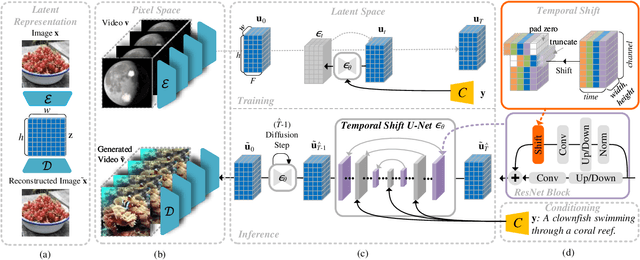
Abstract:We propose Latent-Shift -- an efficient text-to-video generation method based on a pretrained text-to-image generation model that consists of an autoencoder and a U-Net diffusion model. Learning a video diffusion model in the latent space is much more efficient than in the pixel space. The latter is often limited to first generating a low-resolution video followed by a sequence of frame interpolation and super-resolution models, which makes the entire pipeline very complex and computationally expensive. To extend a U-Net from image generation to video generation, prior work proposes to add additional modules like 1D temporal convolution and/or temporal attention layers. In contrast, we propose a parameter-free temporal shift module that can leverage the spatial U-Net as is for video generation. We achieve this by shifting two portions of the feature map channels forward and backward along the temporal dimension. The shifted features of the current frame thus receive the features from the previous and the subsequent frames, enabling motion learning without additional parameters. We show that Latent-Shift achieves comparable or better results while being significantly more efficient. Moreover, Latent-Shift can generate images despite being finetuned for T2V generation.
Text-Conditional Contextualized Avatars For Zero-Shot Personalization
Apr 14, 2023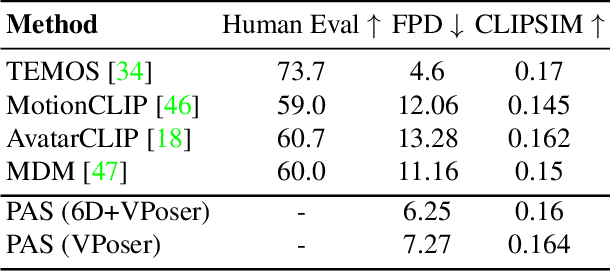

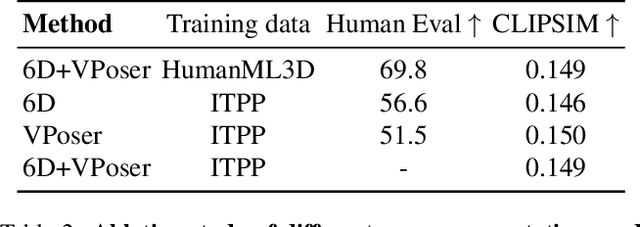
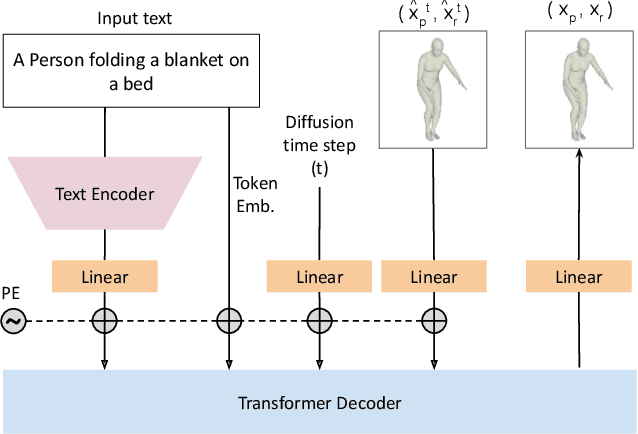
Abstract:Recent large-scale text-to-image generation models have made significant improvements in the quality, realism, and diversity of the synthesized images and enable users to control the created content through language. However, the personalization aspect of these generative models is still challenging and under-explored. In this work, we propose a pipeline that enables personalization of image generation with avatars capturing a user's identity in a delightful way. Our pipeline is zero-shot, avatar texture and style agnostic, and does not require training on the avatar at all - it is scalable to millions of users who can generate a scene with their avatar. To render the avatar in a pose faithful to the given text prompt, we propose a novel text-to-3D pose diffusion model trained on a curated large-scale dataset of in-the-wild human poses improving the performance of the SOTA text-to-motion models significantly. We show, for the first time, how to leverage large-scale image datasets to learn human 3D pose parameters and overcome the limitations of motion capture datasets.
SpaText: Spatio-Textual Representation for Controllable Image Generation
Nov 25, 2022Abstract:Recent text-to-image diffusion models are able to generate convincing results of unprecedented quality. However, it is nearly impossible to control the shapes of different regions/objects or their layout in a fine-grained fashion. Previous attempts to provide such controls were hindered by their reliance on a fixed set of labels. To this end, we present SpaText - a new method for text-to-image generation using open-vocabulary scene control. In addition to a global text prompt that describes the entire scene, the user provides a segmentation map where each region of interest is annotated by a free-form natural language description. Due to lack of large-scale datasets that have a detailed textual description for each region in the image, we choose to leverage the current large-scale text-to-image datasets and base our approach on a novel CLIP-based spatio-textual representation, and show its effectiveness on two state-of-the-art diffusion models: pixel-based and latent-based. In addition, we show how to extend the classifier-free guidance method in diffusion models to the multi-conditional case and present an alternative accelerated inference algorithm. Finally, we offer several automatic evaluation metrics and use them, in addition to FID scores and a user study, to evaluate our method and show that it achieves state-of-the-art results on image generation with free-form textual scene control.
Make-A-Video: Text-to-Video Generation without Text-Video Data
Sep 29, 2022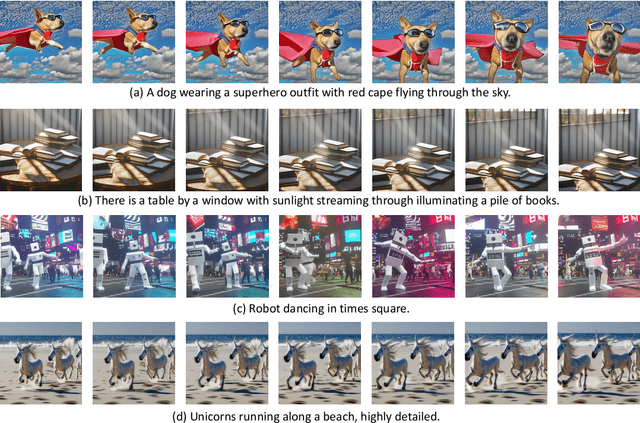

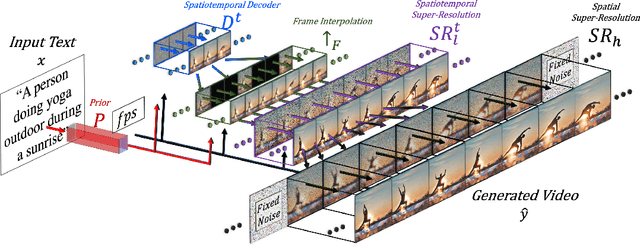
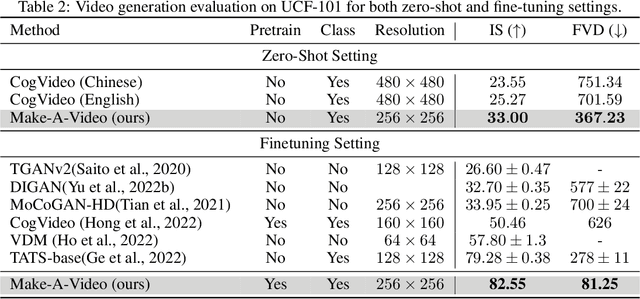
Abstract:We propose Make-A-Video -- an approach for directly translating the tremendous recent progress in Text-to-Image (T2I) generation to Text-to-Video (T2V). Our intuition is simple: learn what the world looks like and how it is described from paired text-image data, and learn how the world moves from unsupervised video footage. Make-A-Video has three advantages: (1) it accelerates training of the T2V model (it does not need to learn visual and multimodal representations from scratch), (2) it does not require paired text-video data, and (3) the generated videos inherit the vastness (diversity in aesthetic, fantastical depictions, etc.) of today's image generation models. We design a simple yet effective way to build on T2I models with novel and effective spatial-temporal modules. First, we decompose the full temporal U-Net and attention tensors and approximate them in space and time. Second, we design a spatial temporal pipeline to generate high resolution and frame rate videos with a video decoder, interpolation model and two super resolution models that can enable various applications besides T2V. In all aspects, spatial and temporal resolution, faithfulness to text, and quality, Make-A-Video sets the new state-of-the-art in text-to-video generation, as determined by both qualitative and quantitative measures.
CCQA: A New Web-Scale Question Answering Dataset for Model Pre-Training
Oct 14, 2021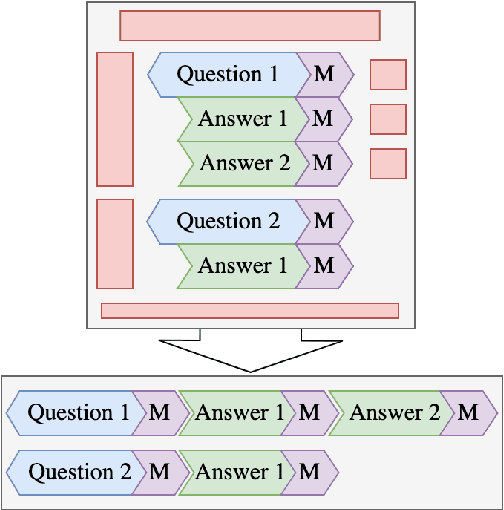



Abstract:With the rise of large-scale pre-trained language models, open-domain question-answering (ODQA) has become an important research topic in NLP. Based on the popular pre-training fine-tuning approach, we posit that an additional in-domain pre-training stage using a large-scale, natural, and diverse question-answering (QA) dataset can be beneficial for ODQA. Consequently, we propose a novel QA dataset based on the Common Crawl project in this paper. Using the readily available schema.org annotation, we extract around 130 million multilingual question-answer pairs, including about 60 million English data-points. With this previously unseen number of natural QA pairs, we pre-train popular language models to show the potential of large-scale in-domain pre-training for the task of question-answering. In our experiments, we find that pre-training question-answering models on our Common Crawl Question Answering dataset (CCQA) achieves promising results in zero-shot, low resource and fine-tuned settings across multiple tasks, models and benchmarks.
Salient Phrase Aware Dense Retrieval: Can a Dense Retriever Imitate a Sparse One?
Oct 13, 2021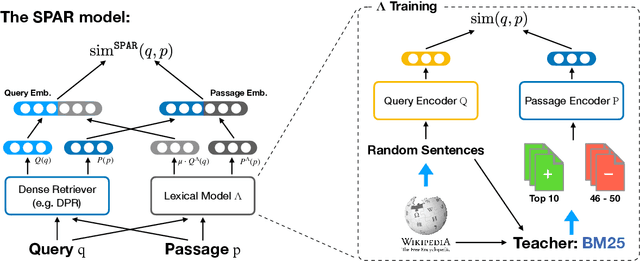
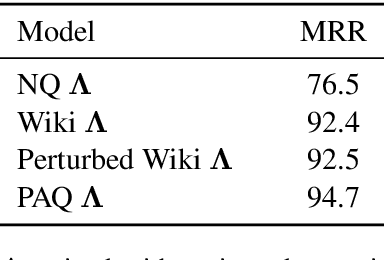
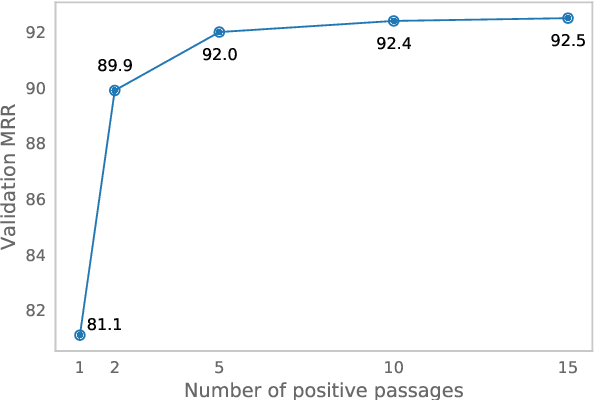
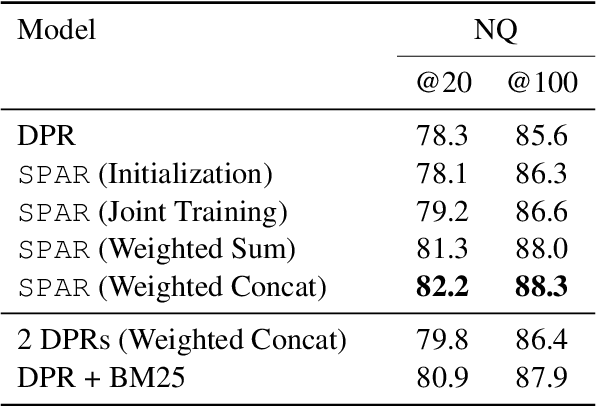
Abstract:Despite their recent popularity and well known advantages, dense retrievers still lag behind sparse methods such as BM25 in their ability to reliably match salient phrases and rare entities in the query. It has been argued that this is an inherent limitation of dense models. We disprove this claim by introducing the Salient Phrase Aware Retriever (SPAR), a dense retriever with the lexical matching capacity of a sparse model. In particular, we show that a dense retriever {\Lambda} can be trained to imitate a sparse one, and SPAR is built by augmenting a standard dense retriever with {\Lambda}. When evaluated on five open-domain question answering datasets and the MS MARCO passage retrieval task, SPAR sets a new state of the art for dense and sparse retrievers and can match or exceed the performance of more complicated dense-sparse hybrid systems.
Domain-matched Pre-training Tasks for Dense Retrieval
Jul 28, 2021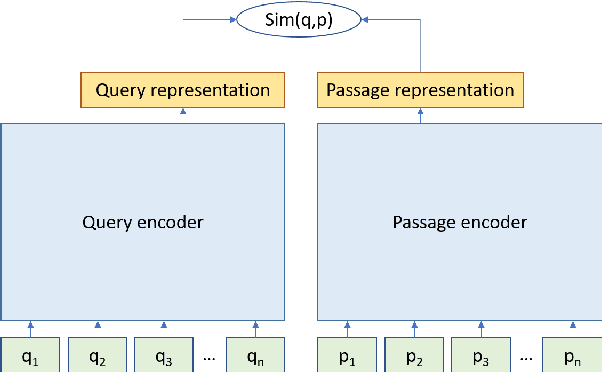
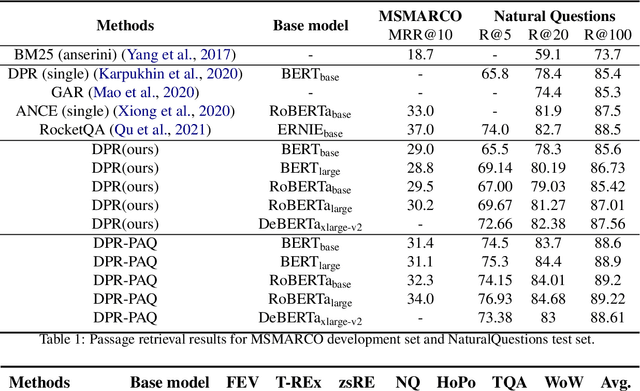

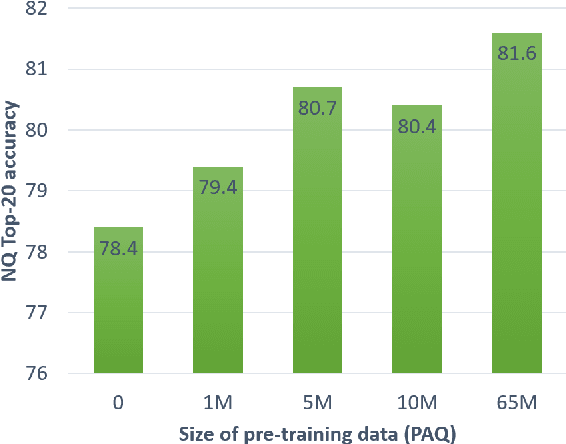
Abstract:Pre-training on larger datasets with ever increasing model size is now a proven recipe for increased performance across almost all NLP tasks. A notable exception is information retrieval, where additional pre-training has so far failed to produce convincing results. We show that, with the right pre-training setup, this barrier can be overcome. We demonstrate this by pre-training large bi-encoder models on 1) a recently released set of 65 million synthetically generated questions, and 2) 200 million post-comment pairs from a preexisting dataset of Reddit conversations made available by pushshift.io. We evaluate on a set of information retrieval and dialogue retrieval benchmarks, showing substantial improvements over supervised baselines.
EASE: Extractive-Abstractive Summarization with Explanations
May 14, 2021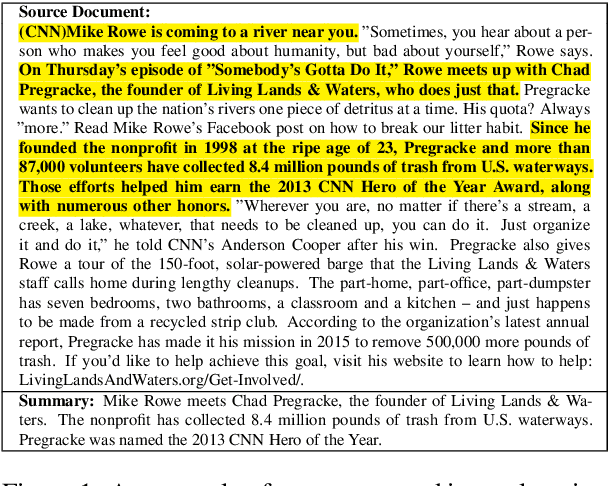
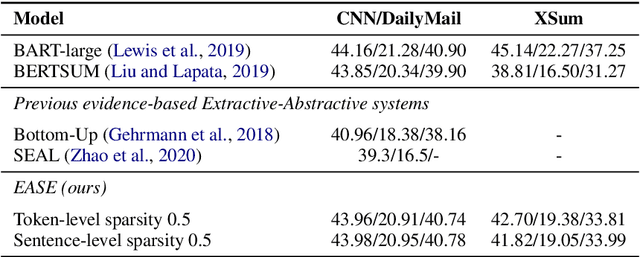
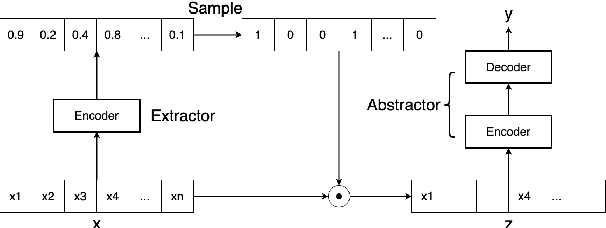

Abstract:Current abstractive summarization systems outperform their extractive counterparts, but their widespread adoption is inhibited by the inherent lack of interpretability. To achieve the best of both worlds, we propose EASE, an extractive-abstractive framework for evidence-based text generation and apply it to document summarization. We present an explainable summarization system based on the Information Bottleneck principle that is jointly trained for extraction and abstraction in an end-to-end fashion. Inspired by previous research that humans use a two-stage framework to summarize long documents (Jing and McKeown, 2000), our framework first extracts a pre-defined amount of evidence spans as explanations and then generates a summary using only the evidence. Using automatic and human evaluations, we show that explanations from our framework are more relevant than simple baselines, without substantially sacrificing the quality of the generated summary.
 Add to Chrome
Add to Chrome Add to Firefox
Add to Firefox Add to Edge
Add to Edge